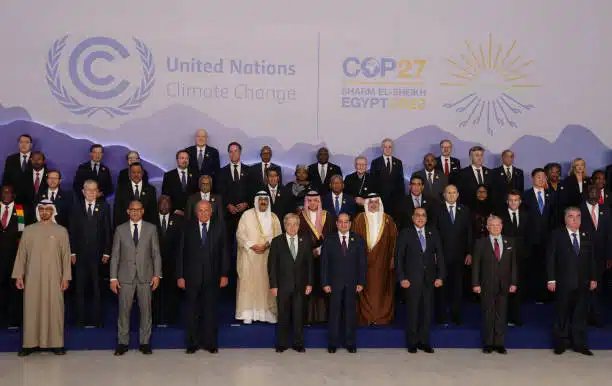- Even though they have contributed the least to global carbon emissions, developing nations of the Global South are the most exposed to these disproportionate effects of climate change.
- Prime Minister Narendra Modi’s recently established “Lifestyle for Environment” (LiFE) initiative, and India’s leadership of the International Solar Alliance and Coalition for Disaster-Resilient Infrastructure.
- The signatories of the Paris Agreement are obligated to create their NDCs or carbon reduction targets, evaluate their performance, and plan future climate commitments.
- The existing promise of $100 billion per year in financial aid from rich nations for both mitigation and adaptation is severely insufficient to help developing nations adjust to intensifying climate consequences.
As the globe gathers at COP’27 in Sharm El-Sheikh, Egypt to reevaluate and restate efforts urgently necessary to prevent global warming and adapt to its effects, the newly released Adaptation Gap Report 2022 from the United Nations Environment Programme paints a troubling picture.
Even if the world begins to reduce greenhouse gas emissions, it is anticipated that climate change consequences would rise in frequency and intensity during the next decade (GHGs). Even though they have contributed the least to global carbon emissions, developing nations of the Global South are the most exposed to these disproportionate effects of climate change.
According to the study ‘Climate Change 2022: Impacts, Adaptation, and Vulnerability by the Intergovernmental Panel on Climate Change (IPCC), around 3.6 billion people live in highly susceptible climate situations. This group is mostly concentrated in emerging nations of the global South. Inadequate capacity, equality, resources, and preexisting development obstacles, limit these nations’ ability to reduce or adapt to unpredictable climate hazards. In the absence of further measures, this situation is likely to deteriorate further, with disadvantaged groups in developing nations being at the forefront of the crisis.
To limit global warming to 1.5°C, global emissions must be cut in half by 2030 and reach zero by 2050. However, existing global climate pledges fall short of limiting climate change to the agreed-upon thresholds. The global powers have manifestly failed to give meaningful leadership on climate change. Developing nations will turn to COP’27 for a strong new leader capable of filling the void in climate governance and promoting collective efforts to combat climate change to confront the unpredictability and expected severity of future climate repercussions.
India: A Rising Global Climate Leader
India is in a position to fill this need. By taking decisive steps toward reducing and adapting to climate change, India has demonstrated great qualifications, dedication, and leadership potential. India is the only G20 nation on pace to meet its climate objectives.
India has pledged in its recently updated Intended Nationally Determined Contribution (NDC) to reduce the emissions intensity of its GDP by 45 percent by 2030, compared to 2005 levels, and to achieve a cumulative electric power installed capacity of approximately 50 percent from non-fossil fuel-based energy resources by 2030. Prime Minister Narendra Modi’s recently launched “Lifestyle for Environment” (LiFE) initiative, and India’s leadership of the International Solar Alliance and the Coalition for Disaster Resilient Infrastructure, is a shining examples of how stronger climate actions can be successfully aligned with the development imperatives.

But how can India utilise its influence at COP’27 to press for a fair and inclusive framework that can transform the agreed climate goals into action? How can India guarantee that meaningful development partnerships are established at COP’27 to assist developing nations in managing the numerous climate risks?
India must emphasise the full implementation of the UNFCCC’s premise of Common but Differentiated Responsibilities and Respective Capabilities while advocating for “fair discussions” at COP’27 (CBDR–RC). Not only are the developing economies less responsible for global warming, but their present emissions per capita are also rather modest.
It would be unreasonable, for instance, to ask a developing country like India, which emits less than 1.9 Mt CO2 per capita, to shoulder the comparable expenses associated with climate initiatives as industrialized nations like the United States (US), which produces 15.52 Mt CO2 per capita. India must remain steadfast in its demand that developing nations be granted sufficient time, financial and technological help, and policy flexibility to transition to a future with lower carbon emissions.
India: Climate Change Impacts
The existing architecture of climate governance lacks clarity around what constitutes a “fair share” of GHG reductions for each country. The signatories of the Paris Agreement are obligated to create their NDCs or carbon reduction targets, evaluate their performance, and plan future climate commitments.
In the absence of a fair and transparent method to assess the sufficiency of each country’s NDCs, there would continue to be a significant policy gap in developed nations’ climate change mitigation efforts. The UNEP notes that developed G20 nations, collectively responsible for over 75% of global GHG emissions, are not on track to reach their climate goals.
As a representative of the poor world, India should urge the developed, wealthier nations to increase their climate action efforts. This effort must lead COP’27 to become an occasion for developing nations to reaffirm their common views on the principles of fairness and inclusion in charting a global route for climate objectives.
In addition, India should increase its pressure on wealthy nations to increase their financial and technological transfer commitments. This would aid poor nations in strengthening their resilience and adapting to climate change and the consequent calamities. According to the IPCC study, between 2010 and 2020, climate-induced severe weather events such as droughts, floods, and storms killed 15 times as many people in extremely vulnerable poor nations than in industrialized, wealthier ones.
The UNEP predicts that developing nations would require between US$140 billion and US$300 billion yearly by 2030 to cover adaptation expenditures, which range from US$70 billion per year now. The existing promise of $100 billion per year in financial aid from rich nations for both mitigation and adaptation is severely insufficient to help developing nations adjust to intensifying climate consequences.
To address adaptation issues, the international community must guarantee that people with high vulnerability have the necessary financial, technological, increased capability, and institutional resources. India must insist that COP’27 establishes a comprehensive set of rules on the mobilization of climate financing for adaptation, its sources, and a governance and accountability system that can facilitate its successful implementation.

Most importantly, while the introduction of “Loss and Damage” (L&D) as an agenda item at COP’27 is a positive move for vulnerable nations, India must ensure that negotiators deal with the problem constructively and give it the urgent attention it needs.
Even the most successful adaptation efforts would not be able to avert all losses and damages in sensitive locations, according to the IPCC. The Santiago Network on Loss and Damage (SNLD) can “catalyse the technical assistance of relevant organisations, bodies, networks, and experts, for the implementation of relevant approaches for preventing, minimizing and addressing L&D at the local, national, and regional levels, in developing countries that are particularly vulnerable to the negative effects of climate change.” COP’27 will be India’s best opportunity to advocate for the development of a dedicated financial mechanism to assist vulnerable areas in coping with climate consequences robustly and efficiently.
India has the most significant task at COP’27, which is to bring the world community ‘together for implementation,’ as they must stand in solidarity to combat the escalating climate problem. At COP’27 and G20, the world will closely observe India’s leading position in climate action.
It must persuade the rich world that their inaction or inability to assist poor nations in adapting to the growing effects of climate change will impact the magnitude of future damage. Shortly, this will necessitate more dramatic measures, including higher funding, to combat the climate issue. The world cannot afford to hesitate any longer in enacting ambitious climate action. This COP’27 must be an “Action COP.”
India prepared to host the Women’s World Boxing Championship 2024













